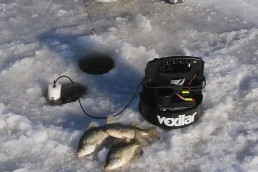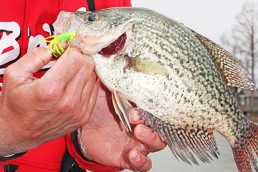Tungsten vs. Lead: Which is Best?
SHARE THIS POST
It doesn’t seem to make a difference what season of the year it is as far as debating the issue of tungsten jigs vs. lead jigs. Over the years this discussion has become somewhat muddled in misinformation that has made the argument of one over the other confusing for the average angler. One thing for sure is there are strong opinions on both sides.
One of the first things I will say is that each has their proper place as far as effectiveness. You probably have seen the big push in advertisements by many manufacturers touting the benefits of using one of their “new” tungsten jigs over the old-style lead jig. That is just good marketing. But I’m not going to say one is better than the other; I will say that there is a proper time and place in which each should be used.
For years, the simple lead jig has accounted for more fish caught than any other lure. It’s easy to use, hard to fish “wrong” with a little practice time put in and it’s very cost effective for anglers. This is especially true if you’re one of those like me who use lead to make your own jigs as a hobby, but also to save money. Due to the snag-infested waters I fish over a normal season, it’s very common to lose many jigs to snags. But by making my own I can then absorb much of that cost. Overall, lead jigs are easy to make and you can have fun doing it.
So, you know now that I tend to favor lead. But again, tungsten also has its place.
Between the two, tungsten is heavier than lead. Because of this it will have a much faster sink rate when used as a jig. Here is where the debate comes into play and why one staunch advocate for one disagrees with the other.
Are you enjoying this post?
You can be among the first to get the latest info on where to go, what to use and how to use it!
Let me set up two different scenarios for you:
First, If I’m fishing a location that has depths no deeper than 15 to 18 feet deep water, I will in most instances opt for my lead-head jigs in the proper weight I feel is necessary—in this situation I’m not really concerned with a really fast fall rate of the jig. Actually, in most instances I would rather have a jig with a slower fall rate for those depths so that as it’s falling through the water column. It’s falling at a slower rate than tungsten, which will equate to more fish being able to see it as it moves down through the water column. This is a bonus for picking off some of those suspended fish that are in the area. So in that respect, heavier is not always better.
For scenario number two, you have located a very deep structure in your favorite lake or river, be it a rock pile, sunken timber or whatever, and see that the fish are schooled tightly to it. You may be fishing this through the ice or from a boat. You’re going to want a lure that you can get down into the fish zone quickly—hence the tungsten. Being heavier than the lead, it will fall much faster through that same water column I discussed above. But here, you want a fast-falling jig so that you can get your presentation down quickly to where fish are holding. This is one of those situations where the fast fall rate will be to your advantage since you are targeting those fish at a particular depth and not worrying about the rest of the water column. In this deeper water in tight-holding fish situations you want to be able to return to that location quickly and the heavier tungsten jig is ideal for this.
It’s great that anglers have an alternative to the lead head jig, but remember, depending on the particular situation and circumstances you are fishing, each jig has its place in your arsenal of jigs. By knowing which particular jig fits right for the situation, you can then be successful with both types.
The debate of tungsten vs. lead will go on, and each has die-hards that will swear by their choice. The best part is that in this world of constant fishing tackle innovations, it’s only a matter of time until the next big thing comes along.
MWO
SHARE THIS POST
Did you enjoy this post?
You can be among the first to get the latest info on where to go, what to use and how to use it!
Mike Cyze
Mike Cyze has been called one of the most knowledgeable multispecies river anglers in the country. His ability to catch fish under the challenging conditions encountered in the river environment, combined with his overall fishing knowledge, has earned him recognition as a true Mississippi River Expert. Contact him at: lastcast13@yahoo.com.



